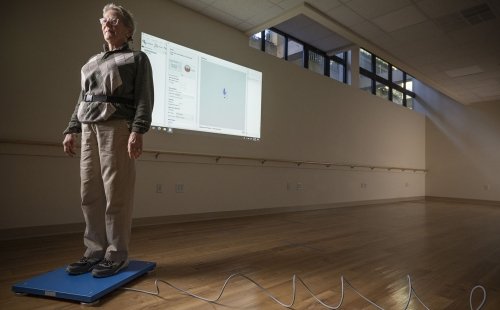
Physical Health and Function
Through the Marcus Institute’s research we are learning how older adults can maintain independence and quality of life.
Research About Maintaining Physical Function as We Age
Mobility is the most common disability among older Americans. More than 40 percent of older adults ages 65-79 have at least one disability in either self-care, household activity, or mobility. For those 80 years and older, this share rises to more than 70 percent.
Moreover, 10 percent of older adults in the community and up to 50 percent in nursing homes have frailty, which is a state of increased vulnerability resulting from a decline in function across multiple systems of the body. The "oldest old" are especially at risk of developing the condition.
Maintaining physical function as we age is key to living independently and continuing the lifestyle and activities that bring us meaning and joy.
The Marcus Institute's research into the physical health and function of older adults focuses in six main areas:
- Mobility
- Nutrition
- Arthritis
- Frailty
- Osteoporosis
- Falls
Marcus Institute Research About Maintaining Mobility and Preventing Frailty in Older Adults
The Marcus Institute's research programs are dedicated to uncovering how physical health and function of older adults impacts their quality of life, and discovering interventions to maintain physical health and function.
Marcus Institute researchers are:
- Investigating innovative methods to measure and apply frailty in various clinical and research settings
- Examining the prevalence, causes, and prevention of frailty
- Studying the prevention and treatment of musculoskeletal disorders including fractures, osteoporosis, osteoarthritis, sarcopenia and hyperkyphosis
- Examining the role of diet and nutrition in bone and muscle health and frailty
- Conducting ground-breaking research in the use of non-invasive brain stimulation to improve mobility and balance and reduce falls among older adults
Explore this section to learn more about current research projects underway to study and improve physical health and function in older adults.
Find current research projects
Showing 39 Results
Optimizing Transcranial Direct Current Stimulation (tDCS) to Improve Dual Task Gait and Balance in Older Adults
This research aims to use personalized transcranial direct current stimulation (tDCS) to improve dual task standing and walking in older adults.
Principal Investigator
Personalized Brain Activity Modulation to Improve Balance and Cognition in Elderly Fallers
This research aims to determine the effects of transcranial direct current stimulation (tDCS) on the control of standing and walking in older adults with previous falls.
Principal Investigator
Predicting and Identifying Risk Factors for Short Time at Home in Older Adults after Hospitalization
This research aims to determine predictors of short time at home after SNF discharge among well-established frailty measures and modifiable risk factors.
Principal Investigator
Prospective Monitoring of Newly Approved Cardiovascular Drugs in Older Adults with Frailty
This research aims to establish a prospective monitoring program in routine healthcare databases for older adults with frailty and identify predictors of benefit from newly marketed drugs for cardiovascular disease.
Principal Investigator
Risk-Guided Atrial Fibrillation Surveillance in Ischemic Stroke
This research aims to evaluate contemporary practices related to the use of an Implantable Loop Recorder (ILS) following ischemic stroke. Our goal is to develop a post-stroke atrial fibrillation (AF) risk prediction model using the national Veterans Health Administration electronic health records (EHR) and externally validate the model in the Boston Medical Center Stroke Database and develop an EHR-based post-stroke AF risk estimation tool and conduct a single-arm pilot test of the EHR tool to evaluate acceptability, adoption, and validity prior to RCT testing.
K23HL151903-01A1
Principal Investigator
Safe Cardiometabolic Drug Prescribing to Prevent Injury in Nursing Home Residents
This research aims to determine the net clinical benefit of cardiometabolic drugs in ADRD and other nursing home residents. Our findings will inform clinical treatment of cardiometabolic disease, prevent injurious falls, and save costs in the nursing home.
NIH R01AG061221
Principal Investigator
Senolytics and Depressive Symptoms in Older Adults at Risk of Alzheimer’s Disease (STAMINA)
This research aims to prevent common age-related impairments in cognition and mobility that lead to the development of Alzheimer’s disease by interrupting one of the fundamental mechanisms of aging, namely the accumulation of senescent cells and their damaging products. We will determine the feasibility of administering Quercetin and Dasatinib to eliminate these cells from the body, and test whether their elimination can improve brain blood flow, cognition, and mobility in older adults at risk of developing Alzheimer’s disease.
Principal Investigators
Successful Aging After Elective Surgery (SAGES)
This research aims to examine the risk factors, causes, and duration of changes in thinking, functioning, and memory after surgery and hospitalization, and in some cases, delirium in older adults. Explore the role of inflammation, Alzheimer’s disease biomarkers, brain plasticity, and complicated delirium.
Principal Investigator
Systemic Contribution of Age-Associated Epigenetic Mechanisms to Osteoarthritis
This research aims to identify potential new targets for Osteoarthritis therapy by identifying key age-associated biological mechanisms underlying Osteoarthritis pathogenesis. The objective of this project is to determine the role of epigenetic changes to genes in key aging pathways on Osteoarthritis.
Principal Investigator
Join a Research Study
I-STIM Study
The goal of the study is to determine whether non-invasive brain stimulation improves balance, walking, and memory in older adults.
I-STIM Faculty
-

Associate Scientist
STAMINA Study
The goal of the study is to determine whether the senolytic medications Dasatinib and Quercetin can reduce senescent cells, increase mobility (walking speed), and improve memory in older adults.
STAMINA STUDY FACULTY
-

Director, Hinda and Arthur Marcus Institute for Aging Research
-

Assistant Scientist
Berries and Steps Study
The goal of this study is to learn about the relationship between antioxidants (commonly found in blueberries) and motivation to exercise. Researchers think that supplementing one's diet with antioxidants on a daily basis may be a practical way to reduce inflammation and improve lack of motivation to exercise.
Berries and Steps Study Faculty
-

Assistant Scientist
tACS and Dual-Tasking Study
The goal is to determine whether non-invasive brain stimulation improves balance and walking.









